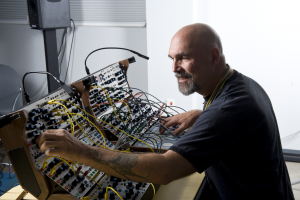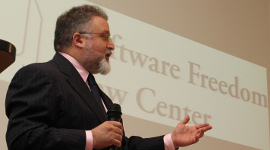
This piece by Bob Ostertag was originally published at On The Commons. We’re reprinting it here because it’s a great description of exactly how distribution networks are still strongly weighted against free-as-in-freedom. The cost of maintaining the monopoly sidewalk is that freedom can grow only in the cracks — and the increasingly eager auto-detection bots keep “repairing” the cracks, because their masters only see the value of the sidewalk. Bob is an active performing and recording musician, and a long-time friend of QuestionCopyright.org (he was one of our founding Board members). His biography is at the end of this article.
We of course hope Bob makes plenty of money from A Book of Hours on CD Baby — there’s no contradiction between freedom-friendly licensing and making money! And yes, we recognize the contradiction between his original Creative Commons Attribution-NonCommercial licensing and the freedom of other artists to pursue the same strategy Bob describes below while incorporating his music in their works. In the usual QCO so-transparent-it’s-kind-of-edgy fashion, we’ll discuss this with Bob and see if he’s open to using truly free licensing while still selling his music on CDBaby and similar sites [Update 2013-08: He was, and we’re now working with him to relicense his music under free licenses wherever possible.]. But the outcome of that conversation doesn’t affect his message below, which is that right now freedom is much harder work than it needs to be, because the major distribution networks still regard it as a weed, and because the few distributors that prioritize a direct audience-artist financial connection are small and don’t have the clout — yet — to change how the sidewalks are maintained.
Update from Bob Ostertag
[This update also comes from the On The Commons article. —QCO Editors] Bob Ostertag’s article (below) about how the music industry makes it increasingly difficult for musicians to share their work online for free got a massive response on On The Commons. Ostertag shares some of the reactions here.
My article seems to have fostered a lots of discussion on OTC, on FaceBook, and around the web. Many shared their own experiences with unjustified “take-downs” of their music off the Web. For example, this form Eva Orgidea:
“Last week Youtube added a copyright notice in one of my videos (a mere sound performance I did in a gallery) saying part of the content was owned by Harry Fox agency. I felt so offended, that I disputed the claim and simultaneously deleted the video. I do not want, in any shape or form, to get involved into those huge corporate names… Nevertheless although I removed the video I am aware that if they do not find my dispute legitimate, they will terminate my Youtube account.”
Others wrote in defense of the people at SoundCloud, which they argue are doing their best given the circumstances, and that their dispute resolution system is actually fast and fairly simple. But beyond discussion of which music and video hosting sites are “good guys” or “bad guys,” the bigger point is that there is a strong incentive for “false positives” built into the whole netbot-auto-take-down system. The software that SoundCloud, YouTube, and others across the web began as a service used by the big labels to analyze music content directly at CD pressing plants to prevent unauthorized mass duplication, That system is now applied to everyone. It is strongly in the interest of the big corporate labels to over-detect rather than under-detect. The result is a system in which the interest of the handful of superstars of the world in not missing out on a penny of their millions in royalties trumps the interest of the vast majority of musicians in getting their music heard.
On YouTube, artists the netbots have identified as violating copyright may now be offered a choice of taking down their video or allowing the alleged copyright holder to advertise on the page. The incentive for false positives here is even stronger, since the more false-positive takedown notices get sent, the more free advertising is muscled from people they have no relationship to: legal, artistic, or otherwise.
Finally, there is one clarification in order concerning my account of the YouTube takedown of Jacques Sirot’s video, which we ultimately traced to netbots operating on behalf of the Seeland label associated with the group Negativland. My intention was to use that story to illustrate how easy it is for copyright-policing-by-netbot to get out of hand, not to question the integrity of Seeland or Negativland. I consider Negativland to be innovative artists, trustworthy collaborators, upstanding individuals, and personal friends. When we finally figured out what had happened, the Negativland people were as horrified as I was and acted immediately to resolve the situation.
Why I No Longer Give Away My Music
How the digital music biz makes it difficult for musicians to offer free downloads
In 2006 I gave my music away. That music had previously existed on CDs and LPs (yes, I began making music in the days of vinyl and tape). I moved all of it to the Web, downloadable for free.
Today, seven years later, I see that giving away music for free is not as easy as I had imagined. In some ways, it turns out to be impossible. The reasons why this is so say a lot about creativity,property, and power in a networked world of corporately owned digital commons policed by netbots and stochastic algorithms.
My music is now available under a Creative Commons “Attribution-Non Commercial 2.5 License,” which allows anyone to download it, copy it, remix it, slice and dice it, and so on. They just can’t sell it, or profit from it. If they incorporate it into music of their own, they should note that they did so, and since they used my music as their source material for free, they should not charge for their music either.
But that’s all just words. In the real world, I have no resources with which to enforce those conditions. And as we shall see, the problems I have encountered in this endeavor have been entirely in another direction.
Deciding to do this was the easy part, since the “record business” never worked for me in the first place. This was no big surprise, as the record business never worked for most musicians. What is surprising is how many musicians seem either to not know this or to have forgotten it.
The whole structure of the industry put corporate interests first, musician interests a distant second. Actually, this is not quite true. The biggest stars get taken care of pretty well. Lady Gaga should have no complaints. But many people would be shocked to know how many bands whose names they know and CDs they bought never saw any money from those sales. For musicians like myself making “non-commercial” music which does not fit easily any any genre or marketable category, the situation was hopeless from the start.
My income comes from concerts, not recordings (I have performed internationally since 1978). For most of my audience, before the Internet came along just finding my recordings was a major undertaking. Concerts in various parts of the world were often attended by people who travelled long distances to get to the show, hoping to find some recording for sale which they had heard about but were never able to find.
Enter the Internet. Suddenly, world-wide “distribution” of audio recordings – which had formerly required an infrastructure of pressing plants, trucks, ships, planes, warehouses, retail shops, accountants, lawyers, and more – became instantly available to everyone at the push of a button.
Who needs the “record business”? What was a difficult, tentative, and ultimately impossible decision for big name groups like Radiohead was a no-brainer for me. I wrote an essay called The Professional Suicide of a Recording Musician that was widely read and commented upon. I was invited on to the board of a non-profit called Question Copyright, which is all about trying to create a real digital commons.
The first thing that happened after ‘freeing’ my music was that people began to access it in far greater numbers than previously possible. My first release to bypass the CD stage and go directly to the Internet for free download, w00t, was downloaded about 40,000 times. And the total downloads of all my recordings has gone well over 100,000. (Since numerous sites now offer my music for downloading I do not have an accurate total).
But I have learned that “accessing” music and actually listening to it are two different things. Free downloading has created a kind of collector or hoarder who is unique to the digital age. In my university classes, I query my students about their downloading habits, and everyone who is deeply into music has figured out how to download music for free, despite the best efforts of the record business to stop them, and have far, far more music downloaded to their laptops and iPods than they will ever have time to listen to in their entire lives. Gigabytes and gigabytes of meaningless data. These same students invariably report that they have actually listened to all the music they paid for.
If a virtual tree falls in a virtual forest and no one opens the file, does it still make a sound? This is a real conundrum. If by “commons” we mean, say, communally owned pastures in England, we are talking about finite resources that were valued as such and cared for accordingly by the surrounding community. But if by “commons” we mean a vast expanse of server farms that seems capable of expanding without meaningful limit, then we are speaking of something very different. Have I cheapened my music by not monetizing its recorded artifact?
For most people for whom new music is an important part of their lives, however, the most relevant commons has become iTunes, Spotify, Pandora and so on – Web sites that allow the user to begin from their favorite music and then link outwards to music that has been somehow identified as similar. College kids and fanatical collectors might work late into the night figuring out how to get their files for free, but for most people, the sites listed above are the main way they discover new music. And these sites do not accept music that is free. They are all about making money. By giving away my music for free, I seem to have shut myself out of the new “commons”.
The Mysterious Case of the Missing Copyright
Jacques Sirot is an independent French artist and film-maker. He used my music as the soundtrack for one of his recent films, as I have made clear he (and everyone else) is free to do. Making sure to dot every i and cross every t, when he posted his film on YouTube he noted: This Creative Commons film uses Bob Ostertag’s music, Say No More, which is distributed with a Creative Commons license; its usage has moreover been personally agreed by the musician.
Yet soon after the film was posted, it was blocked for copyright violation, with a notice that “it may have content that is owned or licensed by IODA [Independent Online Distribution Alliance].” Jacques appealed:
“This video contains elements protected by rights of the author in question, but with the appropriate license or written authorization of the holder of those rights. Bob Ostertag was notified of this use of his music (which he distributes via “Creative Commons”) and granted his authorization. I believe in good faith that the claims described above are not valid, and that I hold the necessary rights to the contents of my video, for reasons cited. I have not knowingly made a false declaration and am not voluntarily using this contestation procedure in an abusive manner to undermine third party rights. I understand that the forwarding of fraudulent contestations can lead to the closure of my YouTube account.”
He received the following reply:
Dear Jacques Sirot,
IODA has reviewed your dispute and reinstated its copyright claim on your video, “TSUNAMI”. For more information, please visit your Copyright Notice page.
Yours sincerely,
The YouTube Team
Working with scholar Sally-Jane Norman, Jaques spent considerable time researching the matter, and eventually contacted me, and I spent hours more looking into it. Finally I figured out what had happened.
Years back, I released some CDs on Seeland, a label run by the notorious media guerrilla group Negativland. Negativland was famously sued for a parody of a song by U2, which made them into icons of free expression and resistance to absurd claims about the reach of copyright. I had left their label years ago when I put my music under the free Creative Commons license. As is often the case with tiny, underfunded labels, there had been a disagreement about accounting, with the Negativland people arguing I owed them money for unsold CDs that were returned by stores. Just the sort of thing that led me to give up on small labels and give away my music. Well, it turned out that, without informing me, Seeland had continued to collect royalties on that music in an effort to recoup what they claimed to be their losses. Through a byzantine circuit of contracts and enforcements, the banishment of Jacques Sirot’s video from YouTube for copyright violation, for using my music which I had given him and everyone else explicit permission to use, was the result of a secret account collecting royalties on my music operated by a label that had built its reputation on resistance to overblown copyright claims!
Kanye West vs. Etienne Noreau-Hebert
There are some Web sites, like YouTube, SoundCloud and BandCamp, which are set up to allow free music and video sharing. But even these are problematic. They are policed by “netbots,” software algorithms that constantly search for sounds allegedly owned by someone or other. My friend Etienne Noreau-Hebert recently uploaded a new work to SoundCloud, to share with others for free, and received back the following reply:
Our automatic content protection system has detected that your sound “121223-Muhamarra-v0.3” may contain the following copyright content: “Love Lockdown (as made famous by Kanye West)” by Future Hit Makers Of America, owned by Big Eye Music. As a result, its publication on your profile has been blocked.
Kanye West, of course, is a major figure in the world of corporate hip hop, with megahit records, movies, a fashion line, and more than 30 million paid digital downloads of his songs. Etienne is an unknown musician making abstract electronic music he would like to share with others for free. There is nothing in his music that sounds even remotely like Kanye West. But some netbot has judged that Etienne has infringed on Kanye’s rights, and so Etienne’s composition is banned from SoundCloud. Perhaps there is someone at SoundCloud to whom Etienne could appeal, if he dug through their web site, sent the emails, waited through various levels of phone robots, etc. Perhaps not. But Etienne is giving away his music for free. Where is he going to get all that time? Or rather, he is trying unsuccessfully to give away his music for free.
Little guys like Etienne are not the only victims of netbot police. The YouTube live stream of Michelle Obama’s speech during the last Democratic Convention was suddenly shut down midsentence by YouTube’s “preemptive content filters,” leaving viewers staring at a black screen with text informing them that: This video contains content from WMG, SME, Associated Press (AP), UMG, Dow Jones, New York Times Digital, The Harry Fox Agency, Inc. (HFA), Warner Chappel, UMPG Publishing and EMI Music Publishing, one or more of whom have blocked it in your country on copyright grounds.
If you want to know who rules the roost on the Internet, that list would be a good place to start. A live webcast of the Hugo Awards for science fiction writers was blocked when a netbot ruled that the stream was showing copyrighted film clips. This was true, but the Hugo Awards had secured permission to use them. No one told the netbots. YouTube’s “preemptive content filters” repeatedly blocked footage from NASA’s Curiosity rover Mars landing, even though the images are in the public domain.
Music for Almost Free
My newest work is A Book of Hours, featuring the extraordinary vocal talents of Shelly Hirsch, Phil Minton, and Theo Bleckman, as well as saxophone legend Roscoe Mitchell. I have decided not to give this one away, but to use a relatively new service with the unlikely name of CDBaby. CDBaby will host the files for download on their site, with all the now-standard ability to share, comment, and so on. But more importantly, they will place the music on iTunes, Pandora, Spotify, and so on. I have to pay them for this service, and they will not accept my work unless I charge for it. I have chosen a very low amount: $1.99 for nearly an hour of music. All my previous works will remain available on my web site for free.
In a way this feels like a retreat from the across-the-board music-for-free stance I have taken for the last seven years. But really I am just trying to keep my head above water in the digital deluge.
Bob Ostertag’s newest work, A Book of Hours, can be purchased here at CD Baby
About Bob Ostertag
Composer, performer, historian, instrument builder, journalist, activist, kayak instructor, Bob Ostertag has published 21 CDs of music, two movies, two DVDs, and three books. His writings on contemporary politics have been published on every continent and in many languages. Electronic instruments of his own design are at the cutting edge of both music and video performance technology. He has performed at music, film, and multi-media festivals around the globe.
His radically diverse collaborators include the Kronos Quartet, avant garder John Zorn, heavy metal star Mike Patton, jazz great Anthony Braxton, dyke punk rocker Lynn Breedlove, drag diva Justin Bond, Quebecois film maker Pierre Hébert, and others. He is currently Professor of Technocultural Studies and Music at the University of California at Davis. For more information, BobOstertag.com



 Eben Moglen will be giving a series of four public talks in New York City, entitled “Snowden and the Future”, starting Wednesday, October 4th (the other dates are Oct. 30th, Nov 13th, and Dec 4th, all Wednesdays).
Eben Moglen will be giving a series of four public talks in New York City, entitled “Snowden and the Future”, starting Wednesday, October 4th (the other dates are Oct. 30th, Nov 13th, and Dec 4th, all Wednesdays).

 A documentary film company making a movie about the “Happy Birthday” song has filed a lawsuit against the music monopolist Warner/Chappell, asking it to return the hundreds of millions of dollars it has collected over the years in improper royalties for the public domain song “Happy Birthday”.
A documentary film company making a movie about the “Happy Birthday” song has filed a lawsuit against the music monopolist Warner/Chappell, asking it to return the hundreds of millions of dollars it has collected over the years in improper royalties for the public domain song “Happy Birthday”.

